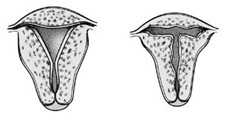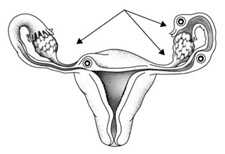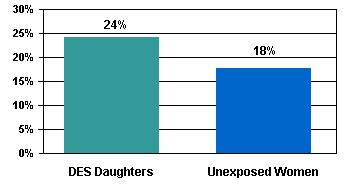


 |
 |
| This section addresses general and specific questions about increased health risks for DES Daughters, including information on
|
|
|
Recent research has confirmed that women exposed to DES before birth (in the womb), known as DES Daughters, are at an increased risk for the following health problems:
- Clear cell adenocarcinoma (CCA) - A rare type of Vaginal and Cervical cancer. Approximately one in 1,000 (0.1 %) DES Daughters will be diagnosed with CCA. The risk is virtually non-existent among premenopausal women not exposed to DES.
- Reproductive tract structural differences - Including T-shaped uterus, hooded cervix, cervical cockscomb, and pseudopolyp.
- Pregnancy complications - Ectopic (tubal) pregnancy and pre-term (early) delivery.
- Infertility - Difficulty becoming pregnant.
The amount of risk for each of these problems varies, and all of these health effects also can occur in women not exposed to DES. The following information provides more detail about each of these health problems.
CCA, a rare form of vaginal and cervical cancer, was the first health problem identified as being associated with DES exposure (Herbst, 1971; Noller, 1972). CCA of the vagina and cervix occurs more frequently in DES Daughters than in women not exposed to DES. DES Daughters are 40 times more likely to develop CCA of the vagina and cervix than women not exposed to DES. This means that approximately one of every 1,000 women exposed to DES before birth (in the womb) will be diagnosed with CCA of the vagina and/or the cervix.
Before the use of DES, CCA of the vagina and cervix only occurred in women past childbearing age. In contrast, DES Daughters have been diagnosed with CCA of the vagina and cervix at as early as age 8 and up to their late teens and early 20s. In addition, recent studies have indicated that some DES Daughters have been diagnosed with CCA of the vagina and cervix in their 30s and 40s (Hatch, 1998). Therefore, DES Daughters should have regular cancer screenings as they grow older.
Some studies have shown that up to one third of DES Daughters have had some form of reproductive tract abnormality of the cervix, uterus, or fallopian tubes, including vaginal adenosis or cervical changes (such as collars, hoods, septae, and cockscombs) (Jeffries, 1984; Herbst, 1984). Many of these changes are harmless and had no effect on physical development, risk of disease, or ability to conceive a child. However, some DES Daughters experienced health problems as a result of reproductive tract abnormalities. DES Daughters should talk with their health care providers about the possibility of reproductive tract structural differences so they can work together to identify and treat any potential problems.
 |
 |

If you are a DES Daughter, it is critical that you tell your health care provider when you begin planning your pregnancy. Many of the risk factors associated with DES exposure during pregnancy are preventable or treatable if you take action. Any pregnancy in a DES Daughter should be treated as "high risk" by health care providers. |
 |
|
 |
 |
 |
Most DES Daughters will be able to conceive and carry a healthy baby to term. However, DES Daughters are at an increased risk of reproductive problems, including complications during pregnancy and infertility.
- Premature Delivery. Consistently, research shows that DES Daughters are at an increased risk for problems during pregnancy. These problems are primarily associated with an increased risk for premature (early) delivery. Of DES Daughters, 64% deliver a full-term baby in their first pregnancy, compared with 85% of unexposed women. Approximately 20% of DES Daughters experience pre-term labor, compared with 8% of unexposed women (Kaufman, 2000).
- Other Pregnancy Complications. DES Daughters are also at an increased risk for other complications during pregnancy, including ectopic (tubal) pregnancy, and miscarriage. Estimates of a DES Daughter's risk for an ectopic pregnancy range from 3-5 times higher than the risk for a woman not exposed to DES. DES Daughters are also more likely to experience miscarriage than are unexposed women. The most recent study found almost 20% of DES Daughters had a miscarriage during their first pregnancy. About 10% of unexposed women had a miscarriage during their first pregnancy. The risk of miscarriage during the second trimester is slightly higher than the risk of miscarriage during the first trimester. Overall, 82%-85% of DES Daughters were able to deliver at least one healthy baby, compared to 87% of unexposed women. DES Daughters were less likely than unexposed women to have more than one child (Kaufman, 2000).
- Infertility. The most recent and comprehensive infertility study reported that 24% of DES Daughters were unable to become pregnant, compared with 18% of women not exposed to DES. Additionally, 28% of DES Daughters have tried for 12 months to become pregnant without success, compared with 16% of women not exposed to DES. DES exposure was most strongly associated with infertility caused by uterine problems (such as the shape of the uterus) (Palmer, 2001).
Back to Top
|
 |
 |
 |
So far, most DES-related cases of CCA of the vagina and cervix have occurred in women in their late teens and early 20s. However, a small number of DES-related clear cell cancers have been diagnosed in women in their 30s and 40s (Hatch, 1998; Herbst, 2000). In the general population, CCA of the vagina and cervix is rare and when found, it occurs in women past childbearing age. Because DES Daughters now range in age from their early 30s to early 60s, many have not reached or are just approaching menopause. Currently, researchers do not know whether DES exposure will make CCA more common when DES Daughters are past menopause. Therefore, DES Daughters should continue to receive regular cancer screening throughout their lifetimes.
No. The increased risk for CCA of the vagina and cervix only applies to DES Daughters and not to women prescribed DES while pregnant.
CCA of the vagina and cervix is treatable when detected early. Therefore, the most important step that any woman can take is to continue to receive regular gynecological examinations throughout her lifetime. The National Cancer Institute (NCI) published a description of appropriate pelvic examinations for DES Daughters. In this publication, recommendations regarding pelvic examinations for DES Daughters were similar to those recommended for unexposed women. Special steps included:
- careful visual examination and palpation (feeling) of the vagina and cervix with rotation of the speculum so that all vaginal walls can be inspected;
- Pap smears from the cervix and the surfaces of the upper vagina; and
- iodine staining of the vagina and cervix or a colposcopy if abnormalities are detected during the examination.
- Iodine staining allows your health care provider to distinguish healthy tissues from abnormal ones.
- A colposcopy uses a device that works like a magnifying glass, allowing your health care provider to carefully check the vagina and cervix. Your provider may take photographs using the colposcope so that any changes in your condition can be monitored during future examinations (Kaufman, 1995).
Back to Top
|
 |
 |
 |
Although most DES Daughters can successfully conceive and carry a baby to full term, they experience infertility more than unexposed women. The most recent study of infertility among DES Daughters reported that 24% had never become pregnant, compared with 18% of unexposed women. Of DES Daughters, 28% had tried without success to become pregnant over a period of 12 months, compared with 16% of unexposed women (Palmer, 2001).
Reasons for DES-related infertility vary. Recent research indicates that the primary reason for an increased risk of infertility among DES Daughters results from abnormalities in the uterus or fallopian tubes that are associated with exposure to DES before birth (in the womb) (Palmer, 2001).
If you are planning a pregnancy, or if you are already pregnant, tell your health care provider about your DES exposure. Before you become pregnant, you may want to discuss your increased risks with your health care provider, including the risk of infertility, ectopic (tubal) pregnancy, miscarriage, and pre-term (early) delivery.
Once you become pregnant, your health care provider likely will classify you as having a "high risk" pregnancy. This means you should be closely monitored for DES-related complications during your pregnancy. Again, most DES Daughters have no problems becoming pregnant or carrying a baby to full term. Although all women should have good prenatal care, it is particularly important for DES Daughters.
Your risk of experiencing infertility or pregnancy complications depends on what reproductive tract structural difference you have. An "abnormal" structure is not necessarily a faulty one; it could just mean that an organ is shaped differently or has an additional feature that is not usually present (such as a "collar" on the cervix). By itself, an abnormality does not necessarily cause infertility or complicate a pregnancy. In one study, for example, researchers found that women with DES-related changes in the vagina or cervix achieved the same rate of pregnancy as women without those abnormalities (Cousins, 1980). However, other research has indicated that abnormalities in the uterus have been associated with an increased rate of ectopic (tubal) pregnancy and miscarriage (Kaufman, 1980, 1984).
Most physical or structural differences associated with exposure to DES are found in the reproductive tract, including a "hood" or collar on the cervix, T-shaped uterus, and non-cancerous vaginal adenosis. Vaginal adenosis, one of the most common changes experienced by DES Daughters, occurs when the vagina has an unusual type of tissue on its surface. Adenosis is often associated with excess mucous in the vagina and can be mistaken for a vaginal infection. Vaginal adenosis, like many DES-related physical changes, is harmless and requires no special treatment. However, health care providers should monitor all DES-related abnormalities for changes over time (Kaufman,1995).
A normal cervix, and one with a "hood" (right)

The inside of a normal and a "T" shaped uterus (right)

Any pregnant woman who is classified as being "high risk" because of DES exposure or any other reason should work with her health care provider to establish a plan of action based on her increased health risks. Preconception counseling with your OB/GYN will help you learn about the risks of infertility and pregnancy complications including ectopic (tubal) pregnancy, miscarriage, premature labor, and premature birth. No single test, treatment, or screening is needed because of your exposure to DES, but your health care provider may recommend that you undergo certain tests or screenings appropriate for your risks. Some example procedures given to "high risk" women during pregnancy and pre-conception examinations include:
- a pelvic examination to check for any cervical changes such as collars, hoods, septae, and cockscombs; and
- if you have experienced infertility, a hysterosalpingogram, which is an X-ray that can check for structural differences and physical alterations in your upper genital tract.
Only children who were in the womb at the time their mother was prescribed DES are considered to have been exposed to DES.
To learn more about the increased health risks for DES Daughters, refer to Recent DES Research and DES Bibliography.
|
Back to Top
|
 |
 |
 |






